|
Philadelphia Memories (Part V)
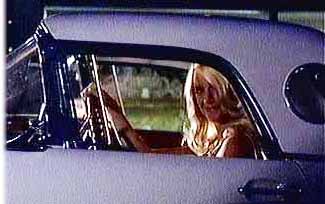 American Graffiti, Philadelphia-Style: I always enjoy watching the 1973 movie, 'American Graffiti'. Set in 1962, it's about a couple of high schools grads who spend on one night hanging out, cruising the strip with their buddies before they go off to college. American Graffiti, Philadelphia-Style: I always enjoy watching the 1973 movie, 'American Graffiti'. Set in 1962, it's about a couple of high schools grads who spend on one night hanging out, cruising the strip with their buddies before they go off to college.
I can identify with it because of the time frame - I graduated from high school in '61 - but have trouble relating to the California setting and the coolness of the cars in the film.
In the 1950s and early '60s, my East Coast adolescent reality was much different than the 'American Graffiti' kids.
California was (and still is) still much more car-centric than Philadelphia. Most of my friends in high school didn't have cool rides. My school buddies who were car guys couldn't do much work on vehicles because of the heavy academic load at our prep school, a lack of funds, too little free time and nowhere to carry out automotive work.
Most of us had crappy minimum-wage summer jobs but had no after-school employment to fund car projects. The intense academic pace kept us plenty busy.
No one at St. Joe's Prep had neat cars like those in 'American Graffiti'. No Suzanne Somers in a white T-Bird. (Of course not. It was an all-boys school.)
No mint-condition, desirable hot rods, either. (No hot rods of any kind, that I can recall.) No one owned a chopped and channeled 1932 Ford. Or a '55 Crown Vicky.
My school friends were mostly ... (more >>>)
Philadelphia Visit: In June 2011, we took an 18 day trip to the Philadelphia area. Since moving to the Pacific Northwest 33 years ago, I've been back to Philly about 20 times.
Every time we visit, there are fewer people to see (some have died, some have moved away) and the changes to the area make it seem much less familiar.
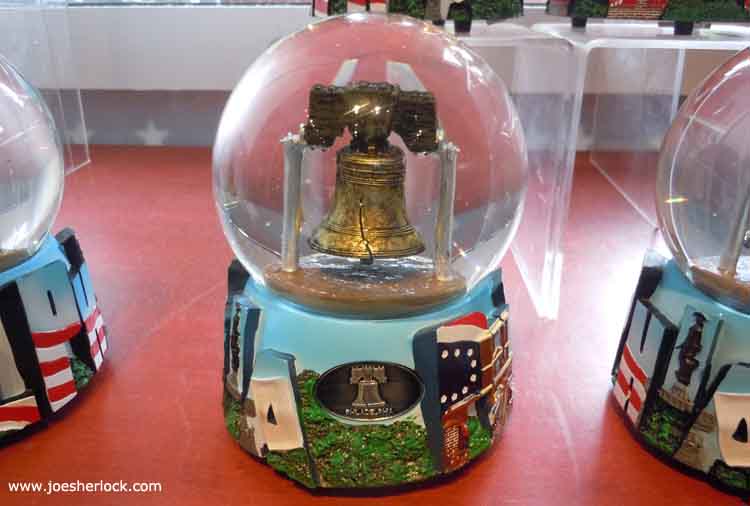
We decided that this trip would be our last ... (more >>>)
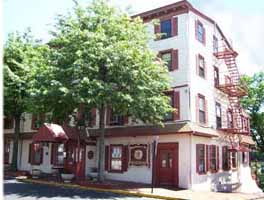 Shuttered History: I just found out that the King George II Inn in Bristol, PA closed its doors last year. Shuttered History: I just found out that the King George II Inn in Bristol, PA closed its doors last year.
The Inn was an institution in the town for 329 years and said to be the oldest operating business in the country. George Washington is reputed to have slept there, although not as President, but as a young man en route to Connecticut to seek a commission.
When I worked at Rohm & Haas, I used to take meetings there frequently. There was a good view of the Delaware River and the food was excellent.
When my dad was very sick, I took my mom to dinner at the King George to give her some caregiver relief. The folks at the King George made us feel welcome and we had a fine meal and a relaxing respite.
There are ongoing efforts to reopen the historic inn. I hope they succeed. (posted 5/12/11, permalink)
A Touch Of Fame: Last week, the Northeast Times, a weekly Philadelphia newspaper with a circulation of 110,000 or so, did a profile of me.

Writer John Loftus was fun to chat with and wrote a very nice piece, titled 'Spinning a Web of Memories'. (posted 5/10/11)
Choo-Choo Park: Recently, the City of Philadelphia renamed a city park in honor of a great industrialist and humanitarian. Matthias Baldwin Park is located on 19th Street, between Callowhill and Hamilton Sts. The ground occupied by the park was once part of the mighty Baldwin Locomotive Works.
In the 1830s, Baldwin transformed the farms around Broad and Spring Garden streets into an expansive steam-engine manufacturing empire. He later expanded west along a railroad line toward the Schuylkill River.
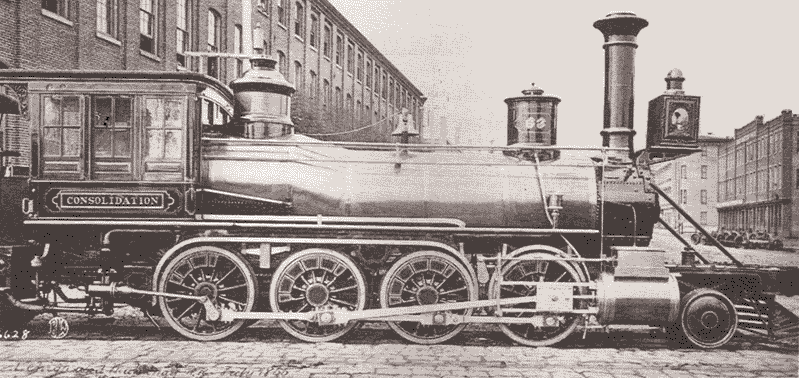
Baldwin locomotive photographed outside the Philadelphia factory in 1866
By 1900, Baldwin was Philadelphia's largest employer with a workforce exceeding 8,200. In 1907, when employment reached 18,500, the firm moved from its cramped 17-acre, 39 building urban site to a more-suitable, roomier 225 acre site in nearby Eddystone, PA.
|
|
The 60,000th locomotive built by Baldwin, #60000 - an experimental 4-10-2 steam locomotive built in 1926, draws a large crowd of onlookers as it is moved - at a speed of four feet per minute - down Vine Street to the Franklin Institute in 1933.
|
Not merely a successful industrialist, Matthias Baldwin was a kind man who treated his workers well and was known for his philanthropic efforts. He was one of the founders of the Franklin Institute, a well-known abolitionist who donated money for a school for African-American children and a proponent of giving black men the right to vote. (posted 4/18/11, permalink)
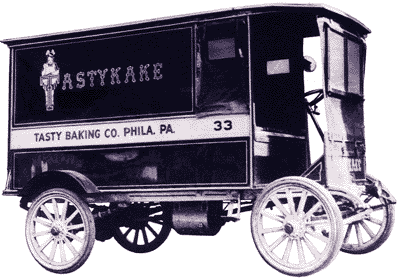 Oh, No! Philadelphia-based Tasty Baking Co., the maker of Tastykakes, has said that financial difficulties are forcing it to consider selling the company. Oh, No! Philadelphia-based Tasty Baking Co., the maker of Tastykakes, has said that financial difficulties are forcing it to consider selling the company.
Tasty said it has asked its lead banker to extend its line of credit and allow for more time in making payments.
It has also hired an investment banker to explore the option of selling the iconic brand.
The company said it is "experiencing extremely tight liquidity," citing a sharp rise in commodity prices, production issues at its new bakery and the bankruptcy reorganization of one if its customers, the Great Atlantic & Pacific Tea Co.
Tasty Baking, which was founded in 1914 in Philadelphia, sells more than 100 products under the Tastykake name, including snack cakes, pies, cookies and doughnuts.
It has manufacturing sites in Philadelphia and Oxford, PA. (posted 1/7/11, permalink)
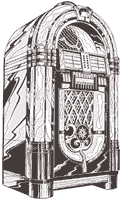 At Least He Made Some Lawn Ornament Guy Rich: Philadelphia-born singer Eddie Fisher has died at age 82. He was once a big deal in the music biz; Fisher had seventeen songs in the Top 10 on the music charts between 1950 and 1956. Kinda before my time, although I do remember his 15 minute television show, sponsored by Coca Cola. It was called 'Coke Time' ... ironic considering his later taste for blow. At Least He Made Some Lawn Ornament Guy Rich: Philadelphia-born singer Eddie Fisher has died at age 82. He was once a big deal in the music biz; Fisher had seventeen songs in the Top 10 on the music charts between 1950 and 1956. Kinda before my time, although I do remember his 15 minute television show, sponsored by Coca Cola. It was called 'Coke Time' ... ironic considering his later taste for blow.
Every time Fisher appeared on someone else's TV show, he inserted a not-so-subtle pitch for Coke in the dialogue. Obnoxiously so, my ten year-old mind registered.
The music biz only has room for a relatively fixed number of stars, so when rock 'n' rollers appeared, the number of crooners diminished and Eddie Fisher's star dimmed. See also Julius LaRosa, Vic Damone, The Four Aces, Jerry Vale, Johnny Ray, Al Martino, et al. Many of these folks made a fairly good living playing clubs and doing concerts years after their careers peaked. Unlike Eddie, who blew all his money on gambling and drugs (amphetamines, cocaine, etc.) and basically died broke.
Fisher didn't help his popularity by divorcing 'America's sweetheart' Debbie Reynolds (scandalous in the 1950s) and running off with town pump Elizabeth Taylor who later publicly dumped Eddie for Richard Burton. Eddie was married a total of five times.
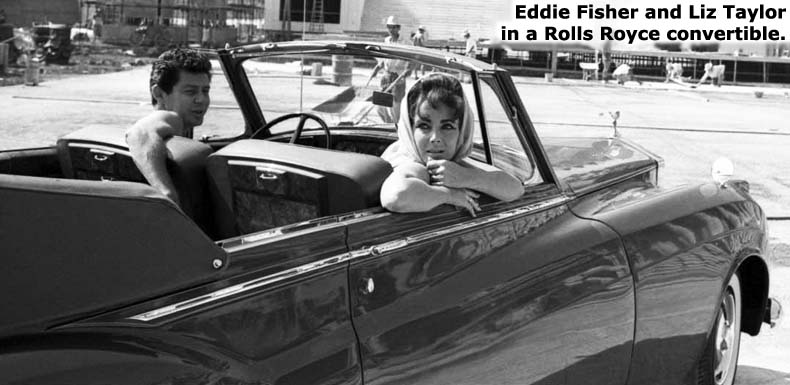
His daughter Carrie was so offended by Eddie's sexually-explicit autobiography that she declared, "That's it. I'm having my DNA fumigated." Alternatively, she could have donned her Princess Leia outfit, gone back in time and shot his nuts off with her Star Wars Defender Blaster.
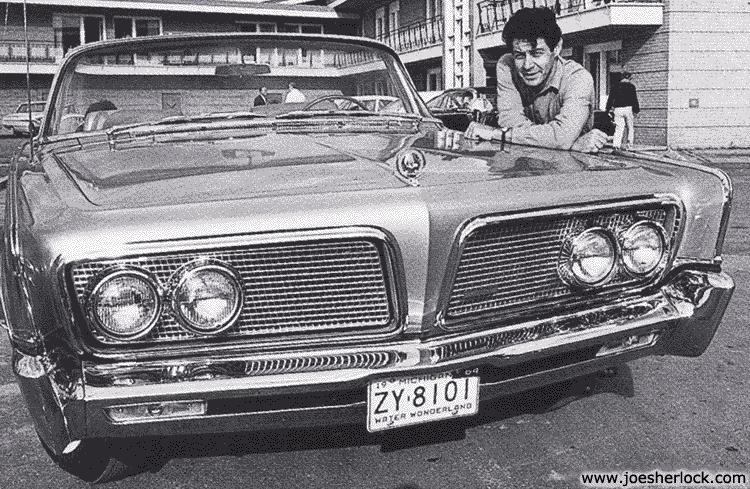
Here's what I remember: Eddie's mom lived on Roosevelt Boulevard in Northeast Philadelphia in a brick twin home purchased by her son during his hi-fame period. You could easily spot the house because it was the only one on the block with lots of concrete detritus on the small front lawn - mirrored gazing balls on pedestals, birdbaths, statuary, etc.
Eddie supposedly bought them for her, proving that his love for his mother was concrete. (posted 10/1/10, permalink)
A Joyful Noise: In Philadelphia, the city is trying to silence the bell of a Catholic church. "For 104 years, the bell at St. John the Baptist Roman Catholic Church in hilly, blue-collar Manayunk has joyfully summoned the faithful to prayer, celebrated marriages and marked the ends of wars.
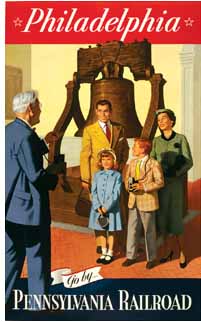 Now, in a city whose many sacred symbols include a cracked bell, someone has filed a complaint to silence St. John's 5,000-pound bronze casting." Now, in a city whose many sacred symbols include a cracked bell, someone has filed a complaint to silence St. John's 5,000-pound bronze casting."
Because someone thinks the bell is too loud.
A letter sent to the church, signed by Roger M. Fey, the Philly's enforcement officer for air and noise pollution, warned "Air Management Services (AMS) has received citizen's complaints of loud amplified sounds from the above premises every day at 7 am. AMS would like to advise you that amplified sound and all other noise ... shall not exceed five decibels above background level measured at the property boundary of the nearest occupied residential property."
Church bells, whether near or far, have always struck my ear as pleasant sounding. I also like ice cream truck bells.
Manayunk is a neighborhood in the northwestern section of the city of Philadelphia, located on the banks of the Schuylkill River. Once a working class place full of textile mills as well as soap and paper factories, the area has become gentrified with lots of loft apartments, upscale shops, bars and restaurants.
Nevertheless, Manayunk retained its small-town charm with its small two- and three-story row homes, cobblestone paving and hilly streets. But, on weekend nights, the streets are full of loud, upscale drunks and gentrified boors. Have any of them ever been presented with a letter from Air Management Services?
Back to the bell: Speedy Morris, head basketball coach at St. Joseph's Preparatory School and a lifelong parishioner at St. John's said, "No one's ever complained before. With people leaving the bars and urinating on the streets, anyone complaining about church bells is ludicrous."
I wonder: When was the last time that Philadelphia's Mr. Fey sent a threatening letter to, say, a mosque for those five-times-a-day, loud, caterwauling calls to prayer?
Just askin'. (posted 9/13/10, permalink)
I'd Like To Suggest A Place Where I'd Stick My FOOT. A news article about Brigantine, NJ begins, "First it was Bennies, then Shoobies. Now there's another derogatory nickname for summer tourists who visit the Jersey shore: FOOTs. It's an acronym for "Out Of Towners" preceded by an obscenity."
Bumper stickers appeared recently on a few cars at Brigantine City Hall with the slogan "I Ain't No FOOT." That prompted memos reminding city workers about appropriate behavior.
"Many locals have long resented summer visitors, blaming them for noise, trash and traffic, while overlooking the added revenue they bring. In northern shore towns, they're called Bennies (an acronym for "Bayonne, Elizabeth, Newark and New York" or variations thereof.) In the south, "Shoobies" refers to the days when New Yorkers and Philadelphians packed their lunch in shoe boxes for trips to the shore."
Brigantine is an island city, just north and east of Atlantic City, covering a mere 6.4 square miles of land. It has neither casinos, a real boardwalk nor an amusement park to draw day-hoppers, so it remains a fairly sleepy town. It has no industry to speak of and its entire economy depends on tourists and the trade of summer residents, most of whom come from Philadelphia and its suburbs.
I last visited Brigantine in October 2008 and, as usual, the post-Labor Day economic blues were easily discernible - most everything was closed.
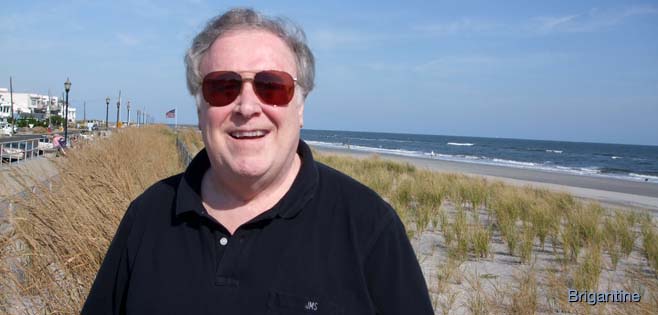
The place where I spent my summers as a teenager was nearly unrecognizable. The Brigantine Country Club's flagship edifice - a stately, two-story clubhouse built next to the bay in 1927 - had been demolished. Twelve "luxury homes" were to be built on its site - someday. I once painted that clubhouse and worked many summers on the golf course, piloting a Ferguson tractor along the fairways.
The Island Diner, where many a Turkey Platter was consumed by yours truly during his formative teenage years, was abandoned. And the fishing and amusement pier at 14th Street North (later known as Brigantine Castle Pier) was gone as well. It burned down in 1987.
These whining Townies - as we used to call them - fail to realize that, without the tourists, their insignificant strip of sand would dry up and blow away.
Hey Brigantine, respect your visitors - they pay your bills and keep your little burg alive. (posted 9/12/10, permalink)
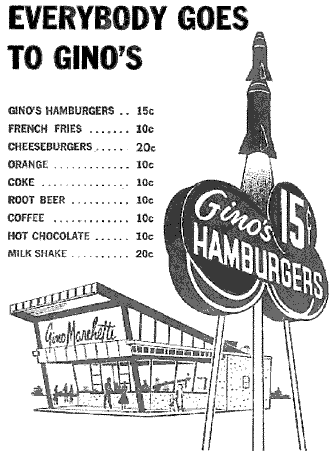 The Return Of The Giant: Remember Gino's Hamburgers? Gino's was known for high quality hamburgers such as the Sirloiner, which was made from sirloin steak, and the Gino Giant, which predated and later competed with the Big Mac. The Return Of The Giant: Remember Gino's Hamburgers? Gino's was known for high quality hamburgers such as the Sirloiner, which was made from sirloin steak, and the Gino Giant, which predated and later competed with the Big Mac.
Gino's pioneered indoor seating at its fast food outlets and in the early 1960s and was more popular in Philadelphia area than McDonald's.
In those days, Gino's advertising slogan was: 'Everybody Goes to Gino's', repeated in print and in radio jingle form.
This East Coast regional fast-food mainstay had over 300 company-owned locations when it was acquired by Marriott Corporation in 1982.
Marriott discontinued the brand, converting stores to Roy Rogers Restaurants.
Now Gino's is making a comeback.
New restaurants will open this year, serving burgers, chicken sandwiches, hand-cut french fries and hand-spun milkshakes. Gino's plans to make its burgers to order from fresh beef.
Initially, the chain plans to open locations in Pennsylvania and New Jersey.
In charge is Tom Romano, who worked for 20 years with the company and was COO in 1982 when the chain was sold.
Cofounded by Baltimore Colts defensive end Gino Marchetti, Gino's was the preferred choice of my buddies and me during our younger years.
My wife and I once had dinner at Gino Marchetti's in the Baltimore area - it was an upscale steakhouse, owned by the same Gino. (posted 7/30/10, permalink)
Book Review: 'You Can't Get to Heaven on the Frankford El' by Thomas J. Lyons II

If you're of a certain age, you'll really enjoy Tom's memoir about growing up in the golden age of postwar America and finding his place in the turbulent, fast moving 1960s. It is an affectionate and nostalgic look back at the late 1940s through mid-1960s. Tom's book is set in Northeast Philadelphia; if you're a Philly native, the names of old hangouts and NJ shore stuff will make you smile and nod. As will the tales of the Frankford El, Philadelphia's ancient, rattly crosstown elevated transit line.
If your ancestry is ... (more >>>)
Philadelphia Trolleys - 1955: Recently, I was looking at a video with the title: 'Philadelphia Trolleys - 1955'. It was 45 minutes worth of footage (transferred from nicely done 16 mm color film) shot in the period 1955-57 by a trolley car enthusiast. While I like trolley cars, I didn't really buy this video to watch trolleys. I wanted to observe the street scenes of Philadelphia to see if the film matched my memories of growing up there in the 1950s.
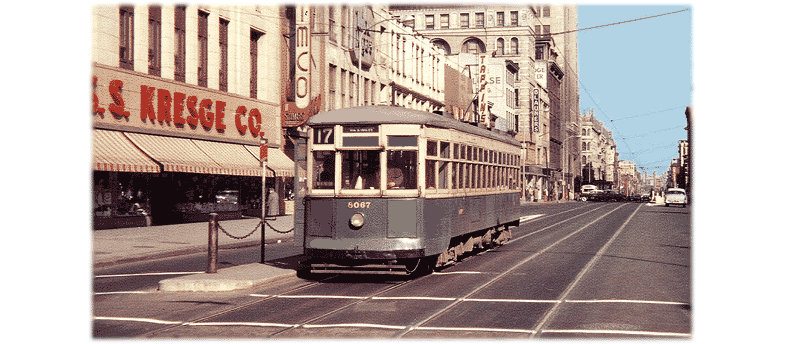
The most interesting things about the video were ... (more >>>)
Another Reason To Feel Old: The Archdiocese of Philadelphia is closing two venerable Catholic high schools in June: Cardinal Dougherty and Northeast Catholic High School for Boys. They are the latest casualties of the archdiocese's perennial problems in the city of rising costs, falling enrollment and competition from publicly-funded charter schools.
Enrollment at coed Dougherty, once the largest Catholic high school in the world, soared to nearly 6,000 students in 1965 - nine years after it opened. The number of students has plunged more than 43% during the last decade.
"The critical reason for the closures of these schools at this time in our history is directly related to the steady decline in these schools' enrollment," said Bishop Joseph P. McFadden.
Jeez, I'm old enough to remember when Dennis Cardinal Dougherty himself was alive. (posted 10/13/09, permalink)
Mayfair Splashdown: Boulevard Pools was one of the main attractions in Northeast Philadelphia between 1929 and the 1960s. Located on Roosevelt Boulevard between Tyson, Princeton, and Brous Avenues, the Mayfair complex was one of the largest and most complete swimming facilities in America. It featured over two acres of pools and cost more than $500,000.
It was composed of four separate compartments that furnished water at varying depths. The diving pool had a 10-foot spring board and a low spring board with a water depth of 10 feet. The main building contained locker rooms for 6,000 people, a large ballroom on the second floor, a restaurant and rest rooms.
The entire property covered seven acres, with grandstands surrounding the pools that seated 3,000 people who could watch water shows, races and thrill-seeking entertainment. Tons of sand were placed around the pools, along with trees and lunch tables, creating what newspapers of the period called "the Northeast's seashore."
In 1930, an alligator-wrestling promotional stunt went horribly awry, when the ten-foot 'gator got free of his mouth bindings and bit two lifeguards, causing one to lose his left hand and arm.
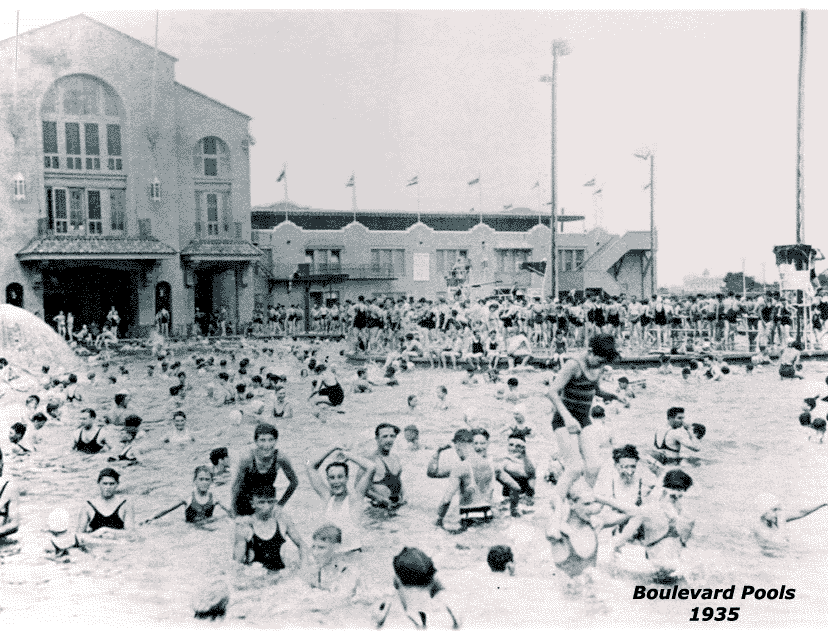
By the 1940s and ’50s, the Boulevard Pools had evolved into a swim club, with members paying yearly fees. The large ballroom was rented out for wedding receptions and parties; regular Friday and Saturday dances were also held on the second floor. I met my wife at a Boulevard Ballroom dance in 1962.
A small amusement park and miniature golf facility were nearby - outside the gates but on the grounds. As a kid, I lived about three blocks from the pool but only swam there a few times. It cost money to get in and swimming in large populous pools was considered a polio risk in those days. I played miniature golf on numerous occasions while munching a cone from the nearby frozen custard stand.
The complex continued to be a popular spot for Northeast residents into the 1970s but increasing operational costs and an aging facility brought the end of Boulevard Pools on Labor Day 1976.
The old real estate is now inhabited by a car dealership, K-Mart, skating rink, housing and a small strip center. (posted 7/15/09, permalink)
 Soft Piracy: Mister Softee, the mobile ice cream vendor and perpetual butt of erectile dysfunction jokes, is taking a stiff stance against impostors who illegally use the corporation's name, slightly-creepy smiling cone-head logo and/or famous jingle. Soft Piracy: Mister Softee, the mobile ice cream vendor and perpetual butt of erectile dysfunction jokes, is taking a stiff stance against impostors who illegally use the corporation's name, slightly-creepy smiling cone-head logo and/or famous jingle.
The U.S. Marshal's Office last month confiscated two ice cream trucks from owners who had been ordered by a federal court judge to stop operating as lookalikes and to reimburse Mister Softee $20,000 in legal fees.
Faux Softees have been known to track legitimate Softees on their routes and start roaming neighborhoods 20 minutes before they arrive.
"The children, they don't know the difference," Jeffrey Zucker, Mister Softee's attorney said.
The company was founded by William and James Conway in 1956 in Philadelphia. It is now one of the largest franchisors of soft ice cream in the United States with 350 or so franchisees operating 600 trucks in 15 states.
The company is headquartered in Runnemede, NJ and is still run by the Conway family.
If you grew up in an area served by Mister Softee, you'll always remember the musical jingle. Fifty years later and from 3,000 miles away, it still sticks in my head. (posted 7/10/09, permalink)
Book Review: 'Remembering Northeast Philadelphia' by Dr. Harry C. Silcox. When you live in a particular area, you're often oblivious to its rich history, the significance of street names or particular buildings. I was reminded of this as I read and reread this fine book.
I grew up in Frankford and Northeast Philadelphia but was unaware of much the region's history. I learned that many of its main roads dated back to the 17th Century: Bridge St. and Frankford Ave.(1683), Oxford, Bustleton and Adams Avenues (1693). The Jolly Post Inn and Tavern opened its doors in 1682 and hosted such colonial-era luminaries as John Adams, Thomas Jefferson, French general Marquis de Lafayette and George Washington himself. It stood on ... (more >>>)
Food Always Tastes Better ... after it has traveled along a conveyor belt.
If you grew up in Philadelphia during the 1940s-60s, you know this to be true. Because every Philadelphian from that era dined at Linton's at least once. For me, watching dishes of hot food travel along the belt was great entertainment - a low-buck sort of dinner theater.
In 1890, Isaiah Linton opened his first restaurant on Front Street in Philadelphia. In 1898, Linton's had Pennsylvania's first "air conditioned" restaurant. Fans positioned in front of blocks of ice blew cool air into the dining room.
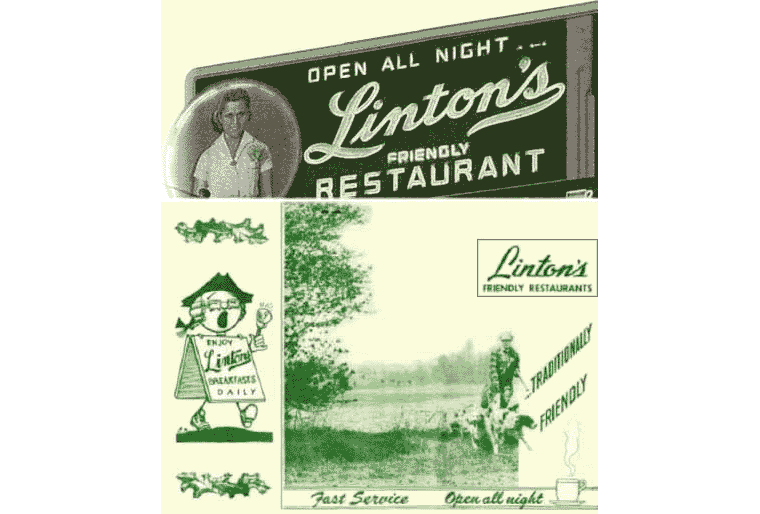
Later on, conveyor belts were installed to quickly move food from the kitchen to the customer. Eventually, Linton’s operated 26 restaurants in the Philadelphia area. Linton's coffee was considered by many to be the best in the area. In my opinion, Linton's made the best Brown Betty dessert.
In the 1970s, competition from the fast food chains led to the restaurant chain's closing. But Linton's still carries on as a commercial food service company. (posted 6/24/09, permalink)
Thank You ... and Good Night: Ed McMahon, the loyal 'Tonight Show' sidekick who bolstered Johnny Carson with guffaws and a resounding "H-e-e-e-e-e-ere's Johnny!" for 30 years, has died at age 86.
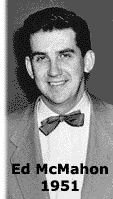 McMahon, whose grandmother was a cousin of Rose Kennedy, put himself through college as a pitchman for vegetable slicers on the Atlantic City boardwalk. He began his television career in Philadelphia at WCAU in 1949. Ed came to Philly to work at WCAU-TV and radio for $75 a week. McMahon, whose grandmother was a cousin of Rose Kennedy, put himself through college as a pitchman for vegetable slicers on the Atlantic City boardwalk. He began his television career in Philadelphia at WCAU in 1949. Ed came to Philly to work at WCAU-TV and radio for $75 a week.
One of his early gigs was a clown on the 1950 'Sealtest Big Top' show, an hour-long, live-broadcast children's variety show, featuring a multitude of circus acts. (Sealtest was a well-known brand of dairy products.) Ed McMahon - in clown makeup, including a blinking nose - opened the show.
"Ed wore a fake bald head wig over his hair as a clown on Big Top," said John Zacherle (aka - Roland), host of WCAU's late-night horror movie. "He started the show by looking into the camera, bowing his head, and 'BIG TOP' was written on his bald spot."
Longtime WCAU personality Gene Crane recalled, "Ed sometimes filled in for me as emcee on Fame and Fortune talent show, which included doing the commercials for Erlanger Beer. The sponsor made him do the commercial over and over, each time drinking a beer. He was a little bombed when he returned to the show but was a pro. Ed was fun and worked harder than any of us."
My mom took me with her when she saw the television cooking show 'Aunt Molly's Den' in 1951 or so. Ed McMahon played Molly's nephew, the handyman. Wearing bib overalls, he would demonstrate simple home repairs while the food was cooking. Former WCAU-TV director/producer Bill Bode recalled a famous on-air flub when announcer McMahon mistakenly referred to Krispy Krackers as 'Krispy Krappers' while the sponsor's ad agency people watched from the control room.
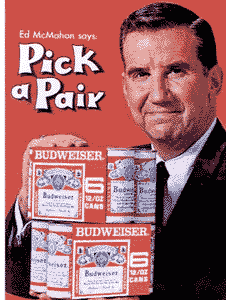 Ed's big break came when Edward R. Murrow met him while in Philadelphia to interview Dick Clark of American Bandstand. Clark and McMahon were neighbors in Drexelbrook apartments in Drexel Hill in the 1950s. Murrow was impressed and Ed soon took a television job in New York with Johnny Carson. The rest is history. Ed's big break came when Edward R. Murrow met him while in Philadelphia to interview Dick Clark of American Bandstand. Clark and McMahon were neighbors in Drexelbrook apartments in Drexel Hill in the 1950s. Murrow was impressed and Ed soon took a television job in New York with Johnny Carson. The rest is history.
Mr. McMahon's last show at WCAU, 'Five Minutes More', was a commentary at the end of the 11:00 pm news. "I was the producer and was only 21," said Jim Hirschfeld, who went on to produce Captain Kangaroo. "Ed and I met everyday for lunch at Cynwyd Lounge on City Line Avenue and wrote the show over two martinis and a hamburger."
Even when 'The Tonight Show' originated from New York City, McMahon kept his Drexel Hill residence. Only when the program moved to the West Coast, did Ed finally break his ties to the Philadelphia area. He also had a shore home in Avalon, NJ.
Millions of younger viewers knew Mr. McMahon as a commercial pitchman: "You may have already won 10 million dollars!" for American Family Publishers' sweepstakes. Or: "Budweiser, the only beer that's beechwood aged."
William Katz has written, "He was a warm, gregarious and totally accessible guy, a former Marine pilot, who seemed genuinely grateful for his luck. ... He was one of the decent guys, in an industry not known for that trait. He represented the last era of the "old" show business, which we sorely miss."
Requiescat In Pace. (posted 6/24/09, permalink)
Mummer's Appearance: On Saturday morning, we gathered 'round the plasma big screen and watched the Portland Grand Floral Parade, the culmination of the 102nd Rose Festival. The skies were cloudy and, towards the end, there was some rain - a Portland tradition - but the parade soldiered on, as always.
There were more than 90 entries, including 15 floats, old cars, equestrian units, dancer troupes, marching bands and llamas. The float count was down considerably; many of the corporate floats were absent - due to the recession, I'm sure. The Battle Ground float - constructed entirely by 100 or so local volunteers - won the President's Trophy. The Battle Ground High School Band took third place in the out-of-state division.
A most pleasant surprise was the appearance of the Philly-based Woodland String Band which has ... (more >>>)
copyright 2009-21 - Joseph M. Sherlock - All applicable rights reserved
Disclaimer
The facts presented on this website are based on my best guesses and my substantially faulty geezer memory. The opinions expressed herein are strictly those of the author and are protected by the U.S. Constitution. Probably.
Spelling, punctuation and syntax errors are cheerfully repaired when I find them; grudgingly fixed when you do.
If I have slandered any brands of automobiles, either expressly or inadvertently, they're most likely crap cars and deserve it. Automobile manufacturers should be aware that they always have the option of giving me free cars to try and change my mind.
If I have slandered any people or corporations, either expressly or inadvertently, they should buy me strong drinks (and an expensive meal) and try to prove to me that they're not the jerks I've portrayed them to be. If you're buying, I'm willing to listen.
Don't be shy - try a bribe. It might help.
|